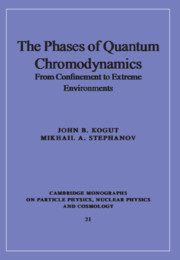Book contents
- Frontmatter
- Contents
- 1 Introduction
- 2 Background in spin systems and critical phenomena
- 3 Gauge fields on a four-dimensional euclidean lattice
- 4 Fermions and nonperturbative dynamics in QCD
- 5 Lattice fermions and chiral symmetry
- 6 The Hamiltonian version of lattice-gauge theory
- 7 Phase transitions in lattice-gauge theory at high temperatures
- 8 Physics of QCD at high temperatures and chemical potentials
- 9 Large chemical potentials and color superconductivity
- 10 Effective Lagrangians and models of QCD at nonzero chemical potential
- 11 Lattice-gauge theory at nonzero chemical potential
- 12 Epilogue
- References
- Index
7 - Phase transitions in lattice-gauge theory at high temperatures
Published online by Cambridge University Press: 17 August 2009
- Frontmatter
- Contents
- 1 Introduction
- 2 Background in spin systems and critical phenomena
- 3 Gauge fields on a four-dimensional euclidean lattice
- 4 Fermions and nonperturbative dynamics in QCD
- 5 Lattice fermions and chiral symmetry
- 6 The Hamiltonian version of lattice-gauge theory
- 7 Phase transitions in lattice-gauge theory at high temperatures
- 8 Physics of QCD at high temperatures and chemical potentials
- 9 Large chemical potentials and color superconductivity
- 10 Effective Lagrangians and models of QCD at nonzero chemical potential
- 11 Lattice-gauge theory at nonzero chemical potential
- 12 Epilogue
- References
- Index
Summary
Finite-temperature transitions at strong coupling
When QCD is heated sufficiently it will undergo a phase transition from a state of colorless strongly interacting particles to a quark-gluon plasma. The properties of this phase transition and properties of the high-temperature plasma are the subjects of a great deal of modern research in QCD.
We have seen that pure gauge-field lattice dynamics confines quarks at strong coupling. If we use the quenched approximation in which there are no internal quark loops, then external static quarks experience a linear confining potential and the only finite-energy states must be color singlets consisting of confined quarks and/or anti-quarks. It is not difficult to show that, if this theory is heated, it will experience a transition to a quark-gluon plasma [43]. The point is that, as the temperature is increased, thermal fluctuations will become large enough to melt the linear flux tube which had produced confinement. At high temperature the vacuum itself becomes a tangle of closed flux loops, bubbling and fluctuating. When a static quark is placed into this vacuum, the extra flux line emanating from it blends into a vacuum already rich in flux and the resulting state does not cost an energy that linearly diverges. In the hot gauge-field state, there is no barrier to generating more or less flux and complete screening of the external, static quark color can occur, no matter what representation of SU(3) it lies in.
Information
- Type
- Chapter
- Information
- The Phases of Quantum ChromodynamicsFrom Confinement to Extreme Environments, pp. 158 - 181Publisher: Cambridge University PressPrint publication year: 2003
